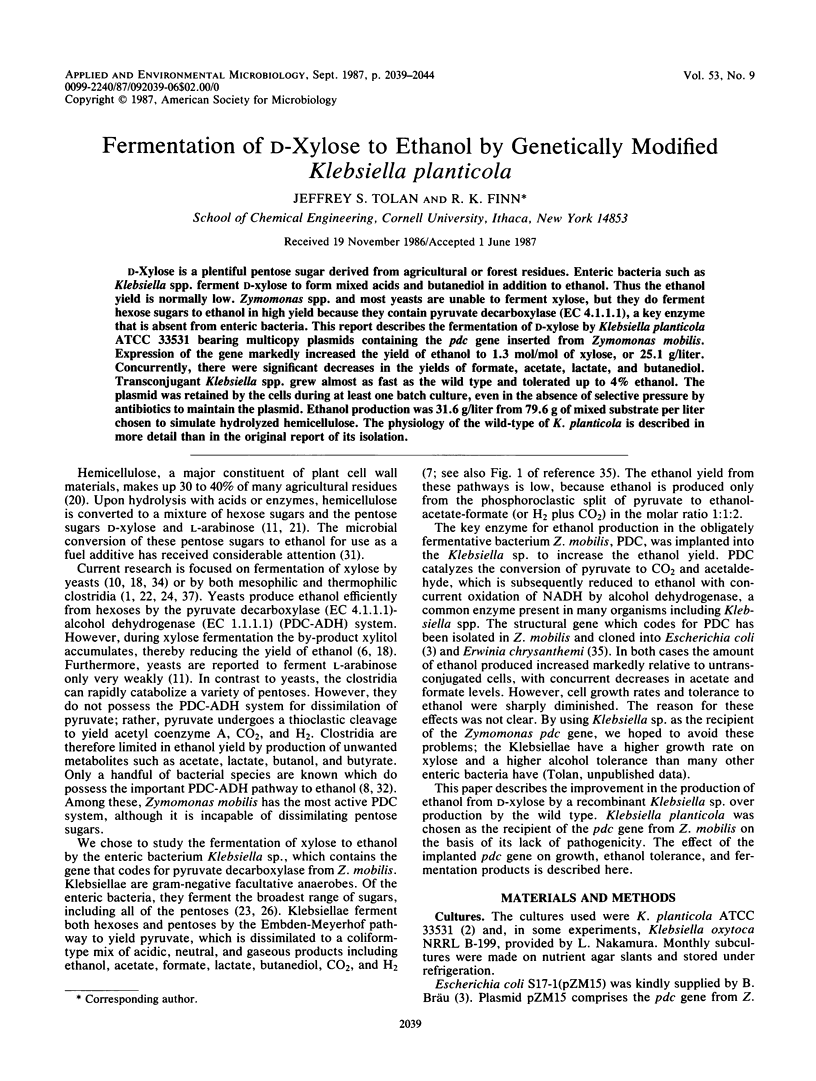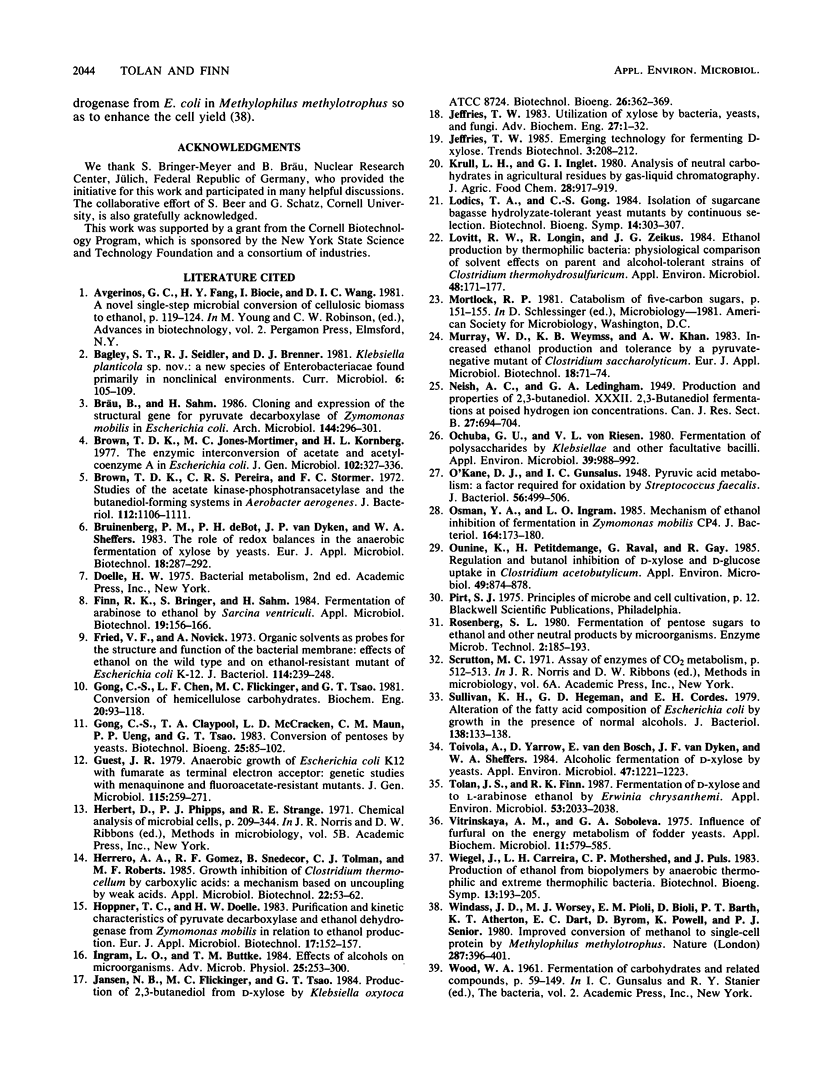Abstract
d-Xylose is a plentiful pentose sugar derived from agricultural or forest residues. Enteric bacteria such as Klebsiella spp. ferment d-xylose to form mixed acids and butanediol in addition to ethanol. Thus the ethanol yield is normally low. Zymomonas spp. and most yeasts are unable to ferment xylose, but they do ferment hexose sugars to ethanol in high yield because they contain pyruvate decarboxylase (EC 4.1.1.1), a key enzyme that is absent from enteric bacteria. This report describes the fermentation of d-xylose by Klebsiella planticola ATCC 33531 bearing multicopy plasmids containing the pdc gene inserted from Zymomonas mobilis. Expression of the gene markedly increased the yield of ethanol to 1.3 mol/mol of xylose, or 25.1 g/liter. Concurrently, there were significant decreases in the yields of formate, acetate, lactate, and butanediol. Transconjugant Klebsiella spp. grew almost as fast as the wild type and tolerated up to 4% ethanol. The plasmid was retained by the cells during at least one batch culture, even in the absence of selective pressure by antibiotics to maintain the plasmid. Ethanol production was 31.6 g/liter from 79.6 g of mixed substrate per liter chosen to simulate hydrolyzed hemicellulose. The physiology of the wild-type of K. planticola is described in more detail than in the original report of its isolation.
Full text
PDF





Selected References
These references are in PubMed. This may not be the complete list of references from this article.
- Brown T. D., Jones-Mortimer M. C., Kornberg H. L. The enzymic interconversion of acetate and acetyl-coenzyme A in Escherichia coli. J Gen Microbiol. 1977 Oct;102(2):327–336. doi: 10.1099/00221287-102-2-327. [DOI] [PubMed] [Google Scholar]
- Brown T. D., Pereira C. R., Stormer F. C. Studies of the acetate kinase-phosphotransacetylase and the butanediol-forming systems in Aerobacter aerogenes. J Bacteriol. 1972 Dec;112(3):1106–1111. doi: 10.1128/jb.112.3.1106-1111.1972. [DOI] [PMC free article] [PubMed] [Google Scholar]
- Fried V. A., Novick A. Organic solvents as probes for the structure and function of the bacterial membrane: effects of ethanol on the wild type and an ethanol-resistant mutant of Escherichia coli K-12. J Bacteriol. 1973 Apr;114(1):239–248. doi: 10.1128/jb.114.1.239-248.1973. [DOI] [PMC free article] [PubMed] [Google Scholar]
- Guest J. R. Anaerobic growth of Escherichia coli K12 with fumarate as terminal electron acceptor. Genetic studies with menaquinone and fluoroacetate-resistant mutants. J Gen Microbiol. 1979 Dec;115(2):259–271. doi: 10.1099/00221287-115-2-259. [DOI] [PubMed] [Google Scholar]
- Ingram L. O., Buttke T. M. Effects of alcohols on micro-organisms. Adv Microb Physiol. 1984;25:253–300. doi: 10.1016/s0065-2911(08)60294-5. [DOI] [PubMed] [Google Scholar]
- Jeffries T. W. Utilization of xylose by bacteria, yeasts, and fungi. Adv Biochem Eng Biotechnol. 1983;27:1–32. doi: 10.1007/BFb0009101. [DOI] [PubMed] [Google Scholar]
- Krull L. H., Inglett G. E. Analysis of neutral carbohydrates in agricultural residues by gas-liquid chromatography. J Agric Food Chem. 1980 Sep-Oct;28(5):917–919. doi: 10.1021/jf60231a013. [DOI] [PubMed] [Google Scholar]
- Lovitt R. W., Longin R., Zeikus J. G. Ethanol Production by Thermophilic Bacteria: Physiological Comparison of Solvent Effects on Parent and Alcohol-Tolerant Strains of Clostridium thermohydrosulfuricum. Appl Environ Microbiol. 1984 Jul;48(1):171–177. doi: 10.1128/aem.48.1.171-177.1984. [DOI] [PMC free article] [PubMed] [Google Scholar]
- O'kane D. J., Gunsalus I. C. Pyruvic Acid Metabolism: A Factor Required for Oxidation by Streptococcus faecalis. J Bacteriol. 1948 Oct;56(4):499–506. doi: 10.1128/jb.56.4.499-506.1948. [DOI] [PMC free article] [PubMed] [Google Scholar]
- Ochuba G. U., von Riesen V. L. Fermentation of polysaccharides by Klebsielleae and other facultative bacilli. Appl Environ Microbiol. 1980 May;39(5):988–992. doi: 10.1128/aem.39.5.988-992.1980. [DOI] [PMC free article] [PubMed] [Google Scholar]
- Osman Y. A., Ingram L. O. Mechanism of ethanol inhibition of fermentation in Zymomonas mobilis CP4. J Bacteriol. 1985 Oct;164(1):173–180. doi: 10.1128/jb.164.1.173-180.1985. [DOI] [PMC free article] [PubMed] [Google Scholar]
- Ounine K., Petitdemange H., Raval G., Gay R. Regulation and butanol inhibition of D-xylose and D-glucose uptake in Clostridium acetobutylicum. Appl Environ Microbiol. 1985 Apr;49(4):874–878. doi: 10.1128/aem.49.4.874-878.1985. [DOI] [PMC free article] [PubMed] [Google Scholar]
- Sullivan K. H., Hegeman G. D., Cordes E. H. Alteration of the fatty acid composition of Escherichia coli by growth in the presence of normal alcohols. J Bacteriol. 1979 Apr;138(1):133–138. doi: 10.1128/jb.138.1.133-138.1979. [DOI] [PMC free article] [PubMed] [Google Scholar]
- Toivola A., Yarrow D., van den Bosch E., van Dijken J. P., Scheffers W. A. Alcoholic Fermentation of d-Xylose by Yeasts. Appl Environ Microbiol. 1984 Jun;47(6):1221–1223. doi: 10.1128/aem.47.6.1221-1223.1984. [DOI] [PMC free article] [PubMed] [Google Scholar]
- Tolan J. S., Finn R. K. Fermentation of d-Xylose and l-Arabinose to Ethanol by Erwinia chrysanthemi. Appl Environ Microbiol. 1987 Sep;53(9):2033–2038. doi: 10.1128/aem.53.9.2033-2038.1987. [DOI] [PMC free article] [PubMed] [Google Scholar]
- Windass J. D., Worsey M. J., Pioli E. M., Pioli D., Barth P. T., Atherton K. T., Dart E. C., Byrom D., Powell K., Senior P. J. Improved conversion of methanol to single-cell protein by Methylophilus methylotrophus. Nature. 1980 Oct 2;287(5781):396–401. doi: 10.1038/287396a0. [DOI] [PubMed] [Google Scholar]


